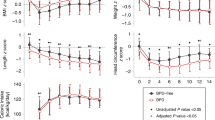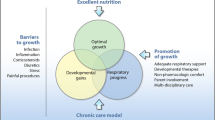Abstract
Objective
To examine nutritional intake profiles and growth trajectories of extremely low birth weight (ELBW) infants who develop severe bronchopulmonary dysplasia (BPD).
Study design
Case-control study using multiple logistic regression analysis with generalized estimating equations (GEE) to adjust for matching.
Results
Cumulative and mean fluid intakes were higher (p = 0.003) and caloric intakes lower (p < 0.0001) through week two in infants who developed severe BPD (n = 120) versus those without severe BPD (n = 104). Mean caloric intake through week 12 was lower in infants who developed severe BPD (102 ± 10.1 vs. 107 ± 8.5 kcal/kg/day, p < 0.0001). In the logistic regression models, lower mean caloric intake through week 12 was associated with increased risk of developing severe BPD. Linear growth reduced the odds of BPD by ~30% for each Z-score point.
Conclusions
Higher fluid and lower total caloric intakes and reductions in linear growth were independently associated with an increased risk of developing severe BPD in ELBW infants.
This is a preview of subscription content, access via your institution
Access options
Subscribe to this journal
Receive 12 print issues and online access
$259.00 per year
only $21.58 per issue
Buy this article
- Purchase on Springer Link
- Instant access to full article PDF
Prices may be subject to local taxes which are calculated during checkout

Similar content being viewed by others
Data availability
The datasets generated and/or analyzed during the current study are available from the corresponding author on reasonable request.
References
Stoll BJ, Hansen NI, Bell EF, Walsh MC, Carlo WA, Shankaran S, et al. Trends in care practices, morbidity, and mortality of extremely preterm neonates, 1993–2012. Jama. 2015;314:1039–51.
Jensen EA, Schmidt B. Epidemiology of bronchopulmonary dysplasia. Birth Defects Res A Clin Mol Teratol. 2014;100:145–57.
Wemhöner A, Ortner D, Tschirch E, Strasak A, Rüdiger M. Nutrition of preterm infants in relation to bronchopulmonary dysplasia. BMC Pulm Med. 2011;11:7.
Massaro GD, Radaeva S, Clerch LB, Massaro D. Lung alveoli: endogenous programmed destruction and regeneration. Am J Physiol Lung Cell Mol Physiol. 2002;283:L305–9.
Mataloun MM, Leone CR, Mascaretti RS, Dohlnikoff M, Rebello CM. Effect of postnatal malnutrition on hyperoxia-induced newborn lung development. Braz J Med Biol Res. 2009;42:606–13.
Malikiwi AI, Lee YM, Davies-Tuck M, Wong FY. Postnatal nutritional deficit is an independent predictor of bronchopulmonary dysplasia among extremely premature infants born at or less than 28 weeks gestation. Early Hum Dev. 2019;131:29–35.
Abman SH, Collaco JM, Shepherd EG, Keszler M, Cuevas-Guaman M, Welty SE, et al. Interdisciplinary care of children with severe bronchopulmonary dysplasia. J Pediatr. 2017;181:12–28.e1.
Jobe AH, Bancalari E. Bronchopulmonary dysplasia. Am J Respir Crit Care Med. 2001;163:1723–9.
McKinley LT, Przystac L, Tucker R, Trail-Burns E, Vohr BR, Laptook AR, et al. Implementation of a nutrition care bundle and improved weight gain of extremely preterm infants to 36 weeks postmenstrual age. J Pediatr. 2022;241:42–7.e2.
Patel AL, Engstrom JL, Meier PP, Kimura RE. Accuracy of methods for calculating postnatal growth velocity for extremely low birth weight infants. Pediatrics. 2005;116:1466–73.
Weinstein MR, Oh W. Oxygen consumption in infants with bronchopulmonary dysplasia. J Pediatr. 1981;99:958–61.
Oh W, Poindexter BB, Perritt R, Lemons JA, Bauer CR, Ehrenkranz RA, et al. Association between fluid intake and weight loss during the first ten days of life and risk of bronchopulmonary dysplasia in extremely low birth weight infants. J Pediatr. 2005;147:786–90.
Bell EF, Acarregui MJ. Restricted versus liberal water intake for preventing morbidity and mortality in preterm infants. Cochrane Database Syst Rev. 2014;CD000503.
Al-Jebawi Y, Agarwal N, Groh Wargo S, Shekhawat P, Mhanna MJ. Low caloric intake and high fluid intake during the first week of life are associated with the severity of bronchopulmonary dysplasia in extremely low birth weight infants. J Neonatal Perinat Med. 2020;13:207–14.
Klevebro S, Westin V, Stoltz Sjostrom E, Norman M, Domellof M, Edstedt Bonamy AK, et al. Early energy and protein intakes and associations with growth, BPD, and ROP in extremely preterm infants. Clin Nutr. 2019;38:1289–95.
Lai NM, Rajadurai SV, Tan KH. Increased energy intake for preterm infants with (or developing) bronchopulmonary dysplasia/ chronic lung disease. Cochrane Database Syst Rev. 2006;19:CD005093.
Miller J, Tonkin E, Damarell RA, McPhee AJ, Suganuma M, Suganuma H, et al. A Systematic review and meta-analysis of human milk feeding and morbidity in very low birth weight infants. Nutrients. 2018;10:707.
Vohr BR, Bell EF, Oh W. Infants with bronchopulmonary dysplasia. Growth pattern and neurologic and developmental outcome. Am J Dis Child. 1982;136:443–7.
Ehrenkranz RA, Dusick AM, Vohr BR, Wright LL, Wrage LA, Poole WK. Growth in the neonatal intensive care unit influences neurodevelopmental and growth outcomes of extremely low birth weight infants. Pediatrics. 2006;117:1253–61.
Talaminos Barroso A, Marquez Martin E, Roa Romero LM, Ortega Ruiz F. Factors affecting lung function: a review of the literature. Arch Bronconeumol. 2018;54:327–32.
Lai SH, Chiang MC, Chu SM, Hsu JF, Yao TC, Tsai MH, et al. Evolution and determinants of lung function until late infancy among infants born preterm. Sci Rep. 2020;10:490.
Sanchez-Solis M, Perez-Fernandez V, Bosch-Gimenez V, Quesada JJ, Garcia-Marcos L. Lung function gain in preterm infants with and without bronchopulmonary dysplasia. Pediatr Pulmonol. 2016;51:936–42.
Hack M, Breslau N, Weissman B, Aram D, Klein N, Borawski E. Effect of very low birth weight and subnormal head size on cognitive abilities at school age. N. Engl J Med. 1991;325:231–7.
Peterson J, Taylor HG, Minich N, Klein N, Hack M. Subnormal head circumference in very low birth weight children: neonatal correlates and school-age consequences. Early Hum Dev. 2006;82:325–34.
Neubauer V, Griesmaier E, Pehbock-Walser N, Pupp-Peglow U, Kiechl-Kohlendorfer U. Poor postnatal head growth in very preterm infants is associated with impaired neurodevelopment outcome. Acta Paediatr. 2013;102:883–8.
Nesterenko TH, Nolan B, Hammad TA, Aly H. Exposure to oxygen and head growth in infants with bronchopulmonary dysplasia. Am J Perinatol. 2008;25:251–4.
Avery ME, Tooley WH, Keller JB, Hurd SS, Bryan MH, Cotton RB, et al. Is chronic lung disease in low-birth-weight infants preventable? A survey of eight centers. Pediatrics. 1987;79:26–30.
Funding
No funding was secured for this study.
Author information
Authors and Affiliations
Contributions
Dr. Kolitz conceptualized and designed the study, designed the data collection instruments, collected data, carried out the initial analyses, and drafted the initial manuscript. Lynn Przystac conceptualized and designed the study, designed the data collection instruments, and reviewed and revised the manuscript. Richard Tucker conceptualized and designed the study, designed the data collection instruments, carried out the initial analyses, and reviewed and revised the manuscript. Dr. Oh conceptualized and designed the study and critically reviewed the manuscript for important intellectual content. Dr. Stonestreet conceptualized and designed the study, coordinated, and supervised data collection, and critically reviewed the manuscript for important intellectual content. All authors approved the final manuscript as submitted and agree to be accountable for all aspects of the work.
Corresponding author
Ethics declarations
Competing interests
The authors declare no competing interests.
Additional information
Publisher’s note Springer Nature remains neutral with regard to jurisdictional claims in published maps and institutional affiliations.
Rights and permissions
Springer Nature or its licensor (e.g. a society or other partner) holds exclusive rights to this article under a publishing agreement with the author(s) or other rightsholder(s); author self-archiving of the accepted manuscript version of this article is solely governed by the terms of such publishing agreement and applicable law.
About this article
Cite this article
Kolitz, D., Przystac, L., Tucker, R. et al. Higher fluid and lower caloric intakes: associated risk of severe bronchopulmonary dysplasia in ELBW infants. J Perinatol (2024). https://doi.org/10.1038/s41372-024-01928-0
Received:
Revised:
Accepted:
Published:
DOI: https://doi.org/10.1038/s41372-024-01928-0



